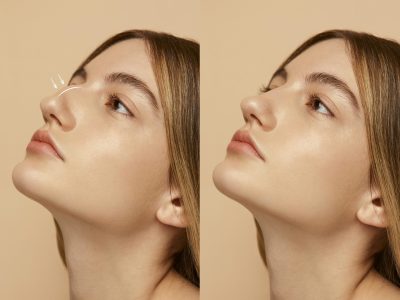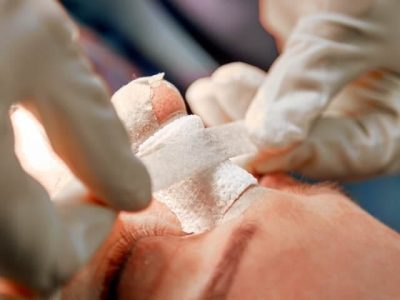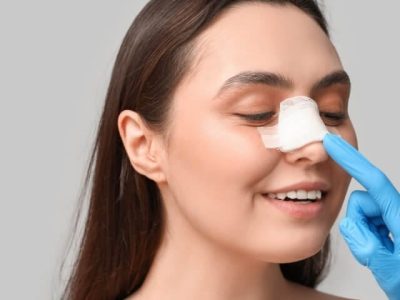Surgical Treatments offer comprehensive and lasting solutions for those seeking significant improvements in facial aesthetics. These procedures involve precise surgical techniques to reshape and enhance facial features, correct structural issues, and address the effects of aging. From rhinoplasty and ear surgery to facelifts and neck lifts, surgical options provide dramatic and natural-looking results that improve both appearance and function. Ideal for individuals looking for permanent changes, these treatments are tailored to meet each patient’s unique needs, ensuring balanced and harmonious outcomes with expert care.
WHO IS A GOOD CANDIDATE FOR RHINOPLASTY?
To be eligible for rhinoplasty surgery, you must be at least 18 years old. However, in rare medically necessary cases, rhinoplasty may be performed on individuals aged 16 or older, provided there is parental consent.
Beyond age, the most important eligibility criteria are determined during the physical examination and consultation. You should be able to fully understand the surgeon’s expectations, clearly articulate your desired outcome, and comprehensively appreciate potential complications—without overlooking any details. Additionally, there should be no serious health issues that could compromise your safety. These factors will be identified during the preoperative evaluation by the ENT specialist and communicated to you before surgery.
Key Eligibility Highlights
- Minimum age: 18 (or 16–17 in rare medically necessary cases with parental approval)
- Emotional and cognitive readiness: Must fully understand goals, outcomes, and risks
- Health status: No serious comorbidities that jeopardize safety
- Preoperative evaluation: ENT specialist confirms candidacy based on these criteria
RHINOPLASTY TECHNIQUES: WHICH TECHNIQUE SHOULD WE SELECT?
Because the desired outcome is more important than the technique used to perform the surgery. Determining which technique to use is a highly technical decision that requires experience and expertise. In practice, we even combine methods, using techniques across different approaches to create a hybrid procedure tailored to each patient.
WILL THERE BE VISIBLE SCARRING?
Closed rhinoplasty leaves no visible scars; open may leave a tiny scar under the nose that typically fades. Even when thetechniqe wit incision is used, in the long term this incision becomes nearly invisible.
HOW PAINFUL IS RECOVERY AFTER RHINOPLASTY?
You won’t experience significant pain during rhinoplasty surgery, and many patients don’t even use painkillers afterward. However, for the first three days, you may feel a lingering fullness and fatigue, as if you’re recovering from a bad flu.
This sensation usually starts to subside after day two, when internal nasal splints (if used) are removed, and it quickly passes afterward.
HOW LONG UNTIL I LOOK NORMAL AGAIN AFTER RHINOPLASTY?
Swelling and under‑eye bruising in the form of lines may occur during the first 7 days. After the protective nasal splint is removed, these typically rapidly diminish, and within about 3 weeks, you’ll enter a phase where swelling and bruising are no longer noticeable.
WHEN CAN I RESUME SPORTS AFTER RHINOPLASTY?
You can start light sports activities about 14 days after surgery. For contact sports, you should wait 6 weeks. After the 3rd month, you may resume any sport you wish—as long as the nose hasn’t sustained any impact
WILL MY NOSE CHANGE OVER TIME?
After the first year post surgery, your nose will start aging just like the rest of your body undergoing natural age-related changes without any additional changes caused by the rhinoplasty.
WHAT IS RECOVERY LIKE AFTER OTOPLASTY?
Whether under local or general anesthesia, most patients are discharged on the same day. During the first two days, both the head and ear bandages are kept in place and not removed. During this period, patients may experience mild, throbbing pain. On the second day, the ear bandages are removed, which brings significant relief to the patient. However, the head bandage should continue to be worn at night for an additional week.
Patients are usually able to carry out all their daily activities the following day. However, a 5-day rest period is recommended before returning to work or school. It is also advised to refrain from engaging in any active sports for 4 weeks.
WHEN WILL I SEE THE FINAL RESULTS AFTER OTOPLASTY?
Swelling subsides within 2 weeks, with most ears settling into shape by then. Final ear definition continues up to 3 months. Patient satisfaction is generally high. Perfect and absolute symmetry is never the goal. A difference of 1–2 mm is inevitable, but such differences are not noticeable to the naked eye. Well-executed otoplasty significantly enhances facial harmony and psychological well-being
WILL I HAVE VISIBLE SCARS AFTER BLEPHAROPLASTY?
Scars are minimal and usually hidden in the natural crease of the eyelid, becoming barely noticeable over time.
WHEN WILL I SEE THE FINAL RESULTS AFTER BLEPHAROPLASTY?
While initial results are visible within a couple of weeks, full results may take up to 1 to 3 months as swelling completely subsides.
WILL THE RESULTS AFTER BLEPHAROPLASTY BE SYMMETRICAL?
Perfect symmetry is not the goal, as natural asymmetries exist. Minor differences (1–2 mm) are normal and not noticeable to the naked eye.
HOW LONG DO THE RESULTS AFTER BLEPHAROPLASTY LAST?
Results typically last 8–10 years or more, depending on skin type and aging.
CAN BLEPHAROPLASTY BE COMBINED WITH OTHER SURGERİES?
Yes. Upper blepharoplasty is often performed alongside procedures such as lower eyelid surgery, brow lift, or facial rejuvenation treatments.
IS ENDOSCOPIC FACE LIFT COMPLETELY SCARLESS?
Endoscopic facelifts are often referred to as “scarless,” but that doesn’t mean there are no scars it means the incisions are very small (20-30 mm) and discreetly placed, usually hidden behind the hairline or in less visible areas.
ARE NERVE INJURIES COMMON?
n the endoscopic approach, both the excellent definition of facial layers and the avoidance of unnecessary tissue elevation significantly reduce the likelihood of nerve injury. Endoscopic cameras often reduce risk, but there remains a small possibility of temporary weakness or altered sensation.
WHEN CAN I GO BACK TO WORK?
Most patients return within 2 weeks, once swelling and bruising subside.
WHAT IS THE DURABILITY OF ENDOSCOPIC FACE LIFT RESULTS?
Expect results to last several years (7-10 years). However, future aging continues, and maintaining good skin care and healthy habits helps prolong effects.





